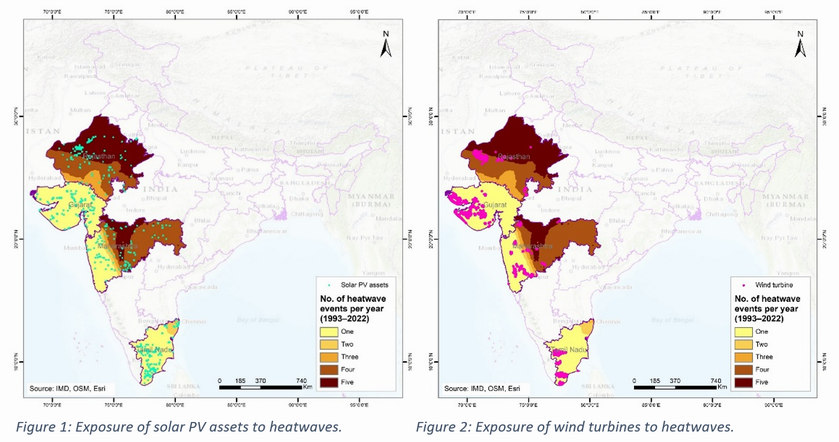
By Tashina Madappa Cheranda, Senior Associate in the Adaptation and Risk Analysis Team, Center for Study of Science, Technology and Policy (CSTEP), Karnataka, India
Extreme heat events are becoming frequent and intense, posing significant risks to human health, agriculture, infrastructure, and ecosystems. To inform adaptation strategies in a hotter future, assessing vulnerability and risk to extreme heat becomes crucial. However, most risk assessments rely on secondary data–based methodologies, which while useful for prioritisation, often lack the granularity needed to guide actionable or effective on-the-ground interventions.
As a researcher at the Center for Study of Science, Technology and Policy (CSTEP), I have had the opportunity to assess climate risks across multiple sectors (agriculture and allied, water resources, energy, human health, etc.). In this article, I would like to highlight the limitations and value addition of such assessments.
In our evaluation of climate risks to renewable energy (RE)[1] assets, heatwaves have emerged as a significant hazard, impacting infrastructure integrity, operational efficiency, and energy production. We used the Intergovernmental Panel on Climate Change (IPCC) Fifth Assessment Report (AR5) risk framework (2014)[2] to identify key drivers of vulnerability for RE assets, such as material degradation, efficiency losses, and cooling demands. While it provided a regional snapshot of heatwave risk to RE assets, the analysis exposed a major shortcoming of such assessments: lack of specificity needed for asset-level adaptation measures to be taken up at scale. Having said that, the study served as a crucial conversation starter, bringing climate risks to RE assets to the attention of key decision-makers. While industry stakeholders were aware of these risks from past experiences, the study helped quantify and visualise the risks, underscoring the significance of such assessments.
I could further explore my sectoral perspective on extreme heat risks through various state-level projects at CSTEP. For example, our historical and current extreme heat risk assessment for Odisha’s agriculture and allied sector was undertaken to prioritise districts for promoting climate resilient agriculture practices. The risk assessments identified five priority districts experiencing systemic heat-related impacts such as water stress due to limited irrigation, low crop insurance coverage, and other socio-economic and technological constraints. However, interactions with regional agriculture experts suggested that extreme heat is not currently a major concern for Odisha’s agriculture and allied sector.
This discrepancy may arise from inherent biases in our risk analyses that depend on coarse-scale climate data, which may not accurately reflect localised heat risks. This example highlights the limitations of projected climate data, which combines coarse resolution with varying degrees of uncertainty. As a result, decision-makers often struggle to justify proactive adaptation measures when immediate threats are not apparent in their lived experiences. Strengthening fine-scale climate data availability and integrating it with ground-level observations could enhance the credibility and utility of extreme heat risk assessments, making them more persuasive for policymakers and practitioners.
Our risk assessments for developing a climate risk visualisation tool for the Union Territory of Puducherry in 2024 focused on key sectors such as agriculture, water resources, urban infrastructure, and public health. Secondary data on human health indicated trends related to heat-related morbidity and mortality, which align with findings from a heatwave health risk index developed for Karnataka.[3]
Through our discussions with healthcare experts, we gained valuable insights into several pressing issues: gaps in awareness, ineffective early warning systems, intersectionality, the disproportionate impact on vulnerable groups, and inadequate policy responses. These recurring challenges underscore the slow and fragmented process of translating research into policy and action. However, this exercise stressed the importance of enhancing the capacity of state-level stakeholders, as their efforts directly shape state policies and programmes. The members of the Puducherry Climate Change Cell (PCCC), for whom we are developing the tool, participated in a phased, pan-India capacity-building programme on vulnerability and risk assessment[4]. As a result, PCCC actively contributed to the tool’s development by identifying key indicators, critically evaluating results based on their field experience, and proposing refinements to improve the assessment. Apart from strengthening the tool’s applicability, this collaborative process fostered a more interactive and dynamic exchange of knowledge.
In conclusion, for adaptation planning to be truly effective, it must go beyond top-down assessments. While quantitative risk models offer valuable insights, their utility is limited without complementary, ground-based assessments. Participatory methods, qualitative data, and a strong understanding of local contexts are indispensable for designing targeted interventions. Thus, addressing extreme heat risks requires a multi-scale approach that combines broad vulnerability frameworks with nuanced, place-based analyses, ensuring that adaptation actions are both context-specific and actionable. Without bridging the gap between assessment and action, we risk repeating the cycle of knowledge generation without meaningful implementation.
[1] United Nations Development Programme. (2024). Mapping the resilience of renewable energy systems and assets in Maharashtra, Gujarat, Tamil Nadu, and Rajasthan to extreme weather events.
[2] Oppenheimer, M., Campos, M., Warren, R., Birkmann, J., Luber, G., O’Neill, B., & Takahashi, K. (2014). Emergent risks and key vulnerabilities. In: Climate change 2014: Impacts, adaptation, and vulnerability. Part A: Global and sectoral aspects. Contribution of Working Group II to the Fifth Assessment Report of the Intergovernmental Panel on Climate Change (Ch. 19, pp. 1039–1099). Cambridge University Press.
[3] Thakkar, V., Vidya, S., Pradeep, M. S., Madappa, T., Anushiya, J., & Murthy, I. K. (2025). Heatwave health risk index for Karnataka, India. The Journal of Climate Change and Health. In press.
[4] Dasgupta, S., Barua, A., Murthy, I. K., Borgohain, P. L., Baghel, T., Sankhyayan, P., Vidya, S., Narwal, H., Jan, A., Vyas, S., Luniwal, Y., Ghosh, S., Cheranda, T. M., Alam, M. K., Matthew, S., & Pradeep, M. S. (2024). District-level climate risk assessment for India: Mapping flood and drought risks using IPCC framework. Department of Science and Technology, Government of India, and the Swiss Agency for Development and Cooperation (SDC), Embassy of Switzerland. https://cstep.in/publications-details.php?id=3074
Disclaimer: The views expressed in this piece are those of the author/s and do not necessarily reflect the views or policies of AIDMI.